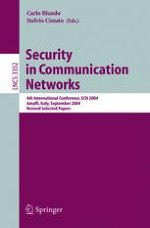The 4th International Conference on Security in Communication Networks 2004 (SCN2004)washeldatthe“DioceseHall”oftheArchdioceseofAmal?-Cavade’ Tirreni and the “Armorial Bearings Hall” of the Archbishop Palace in Amal?, Italy, on September 8–10, 2004. Previous conferences also took place in Amal? in 1996, 1999 and 2002. The conference aimed at bringing together researchers in the ?elds of cr- tography and security in communication networks to foster cooperation and the exchange of ideas. The main topics included all technical aspects of data security, including: anonymity,authentication,blockciphers,complexity-basedcryptography,cry- analysis, digital signatures, distributed cryptography, hash functions, identi?- tion,implementations,keydistribution,privacy,publickeyencryption,threshold cryptography, and zero knowledge. The Program Committee, consisting of 21 members, considered 79 papers and selected 26 for presentation; one of them was withdrawn by the authors. These papers were selected on the basis of originality, quality and relevance to cryptography and security in communication networks. Due to the high number of submissions, paper selection was a di?cult and challenging task, and many good submissions had to be rejected. Each subm- sion was refereed by at least three reviewers and some had four reports or more. We are very grateful to all the program committee members, who devoted much e?ort and valuable time to read and select the papers. In addition, we gratefully acknowledge the help of colleagues who reviewed submissions in their areas of expertise. They are all listed on page VII and we apologize for any inadvertent omissions. These proceedings include the revised versions of the 26 accepted papers andtheabstractoftheinvitedtalkbyBartPreneel(ECRYPT:theCryptographic Research Challenges for the Next Decade).
